The Synchrocyclotron beam ends
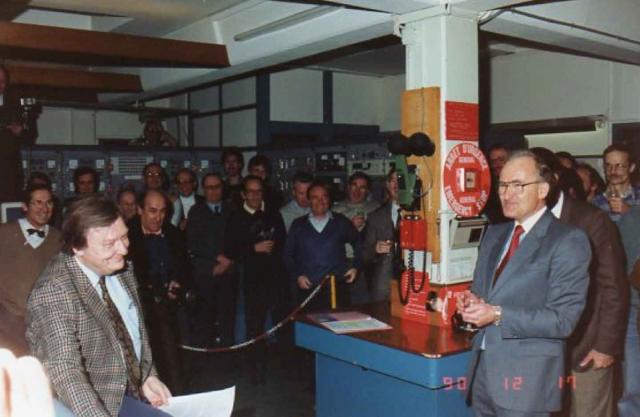
On 19 December 1990, at noon, the beam from the Synchrocyclotron (SC) is stopped. At the end of the eighties the decision was taken to shut down the SC.
The ISOLDE programme should, however, continue at CERN and new facility will be built for an external beam from the Proton Synchrotron Booster.
Inauguration of the new ISOLDE PSB facility
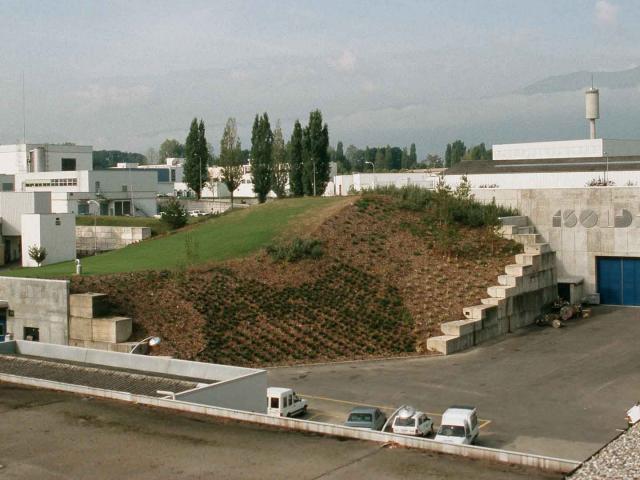
The new ISOLDE PSB Facility has two isotope separators, a general-purpose separator with one magnet (GPS) and a high-resolution separator with two magnets, similar to the ISOLDE III design. The target handling in the facility is fully automatized with robots.
First experiment at the ISOLDE Proton-Synchrotron Booster
First experiment at the ISOLDE Proton-Synchrotron Booster.
The first experiment was carried out on June 26, where the beta-proton decay of the neon isotope with mass number 17 was studied. This experiment was relevant for the understanding of nuclear halo structure, first proposed at ISOLDE.
First use of robots for target interventions

Industrial robots are installed for manipulation of ISOLDE targets, which allows all target changes and manipulations of used target-ion-source systems to be made without human intervention.
New accelerator, REX-ISOLDE, goes live
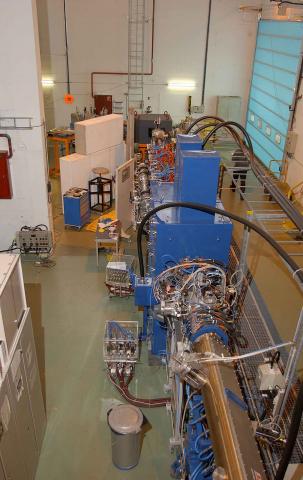
A new accelerator, REX-ISOLDE, is put into operation on 31 October 2001. This post-accelerator has opened up new fields of research using radioactive ion beams of higher energies. REX-ISOLDE can provide post-accelerated nuclei covering the whole mass range from He to U for reaction studies and Coulomb excitation with energies up to 3 MeV/u. To this day, REX has accelerated over 100 isotopes of more than 30 different elements.
Radioactive laboratory of class A at ISOLDE
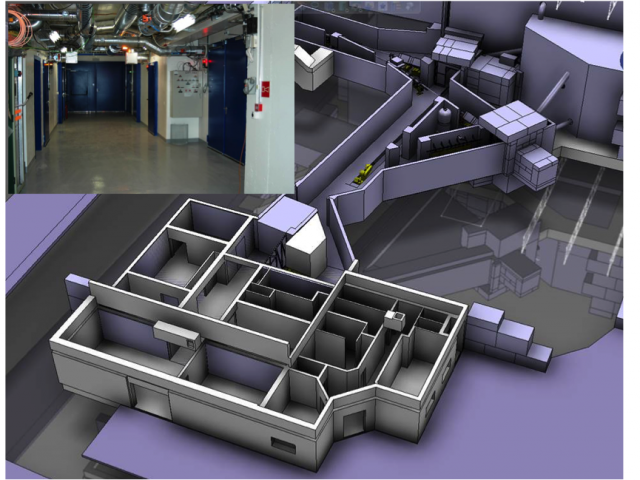
(Image: A 3-D drawing of the Class A Lab with a photo inset)
The new Class A building at ISOLDE is built to enable UCx target material to be produced and irradiated targets to be handled safely. The Class A laboratory is equipped with fume cupboards, full protective measures and aerosol monitoring. It can handle 150 g UO2 per day, corresponding to two target containers.
ISCOOL, the RFQ Cooler and Buncher
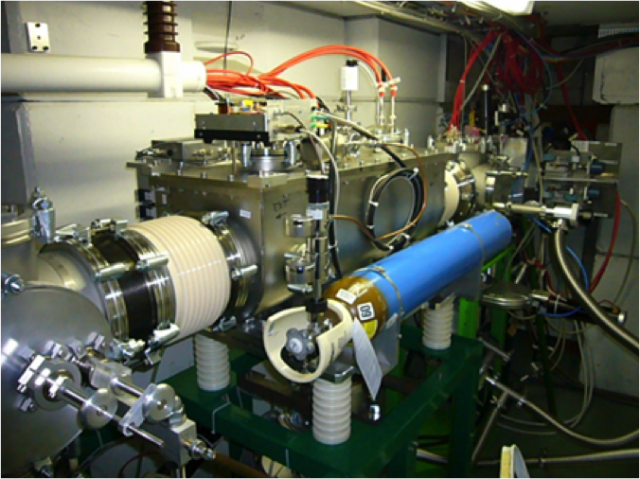
(Image: ISCOOL, an ion cooler and buncher installed at ISOLDE)
An ion cooler and buncher, ISCOOL, is installed in the HRS section of ISOLDE. Beams with strongly reduced emittances and energy spreads are now available for all experiments downstream the beam line.
Using its bunching capabilities, ISCOOL permits an increase in the sensitivity for experiments such as those devotde to collinear laser spectroscopy. The first physics run with this device took place in July 2008 where the isotope 77Ga (T1/2=13 s) was studied with the COLLAPS laser spectroscopy setup.
HIE-ISOLDE project approved
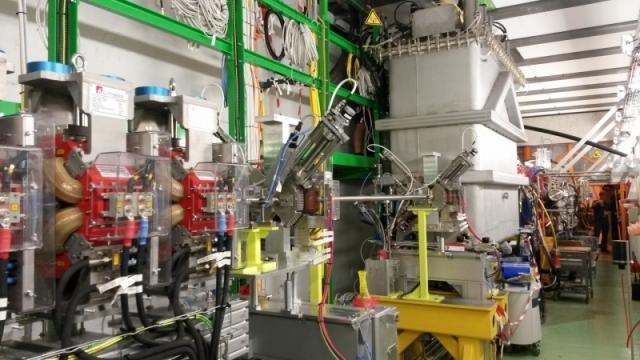
(Image: The ISOLDE beamline, equipped with the first HIE-ISOLDE cryomodule in its light grey cryostat)
The HIE-ISOLDE project is a major staged upgrade of the existing ISOLDE facility. It includes an energy increase of the REX post-accelerator up to 5.5 MeV/u with a future option of going to 10 MeV/u, as well as an upgrade of the REX low energy stage capacity. The beam quality will be improved e.g. with the installation of a RFQ cooler and a new Resonant Laser Ionization System. The driver intensity will be increased from the new Linac-4 and upgrades in the intensity and energy of the PS Booster.
Approval of the CERN-MEDICIS project
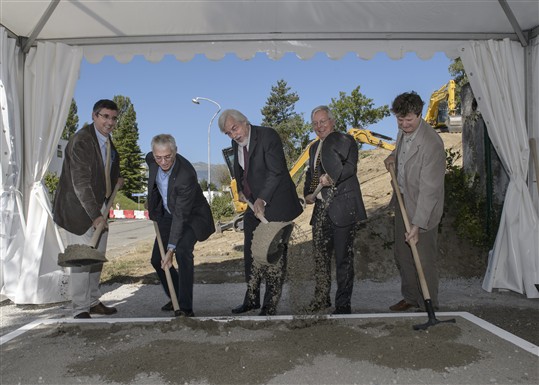
(Image: Groundbreaking for the CERN-MEDICIS building. From left - R. Meuli, Chef du Département de Radiologie Médicale, CHUV, D. Hanahan, Director, Swiss Institute for Experimental Cancer Research R. Heuer, Directeur général, CERN Y. Grandjean Secrétaire général, HUG P. Piet Van Duppen, Nuclear Spectroscopy Group, Katholieke Universiteit Leuven. Credit: Maximillien Brice/ CERN)
CERN-MEDICIS will use the primary proton beam at ISOLDE to produce radioisotopes for medical research. A second target will be placed after the one at ISOLDE as the high energy proton beam only deposits 10% of its intensity and energy when traversing the standard type of ISOLDE target and thus the protons passing through the target can still be used. An automated conveyor will then carry this second target to the CERN-MEDICIS infrastructure, where the radioisotopes will be extracted.
First observations of short-lived pear-shaped atomic nuclei
An international team at the ISOLDE facility showed that some atomic nuclei can assume asymmetric, "pear" shapes. The observations contradict some existing nuclear theories and will require others to be amended. Published in the journal Nature, a technique pioneered at ISOLDE was used successfully to study the shape of the short-lived isotopes Radon 220 and Radium 224.
Most nuclei have the shape of a rugby ball. While state-of-the-art theories are able to predict this behaviour, the same theories have predicted that for some particular combinations of protons and neutrons, nuclei can also assume asymmetric shapes, like a pear. In this case there is more mass at one end of the nucleus than the other.
In contradiction with some nuclear theories, Radium 224 is pear-shaped, Radon 220 does not assume the fixed shape of a pear but rather vibrates about this shape.
Such exotic atoms with pear-shaped nuclei could help with the searches for electric dipole moments (EDMs), that is the separation of positive and negative charges within the atom.